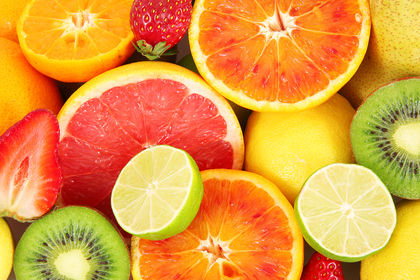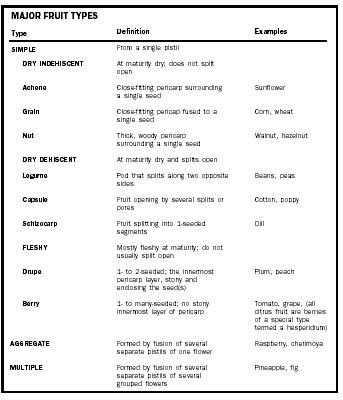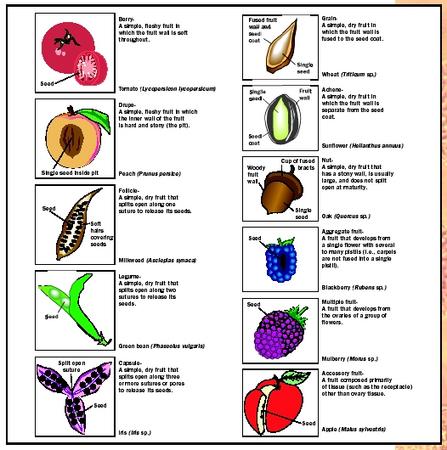Fruits

Fruits are produced only by flowering plants (angiosperms). Following pollination of the flower, the fertilized ovules develop into seeds while the surrounding ovary wall forms the fruit tissue, or pericarp.
Types of Fruits
The botanical definition of a fruit is an organ that contains seeds, protecting these as they develop and often aiding in their dispersal. This may be at odds with everyday usage of the word "fruit." Botanically, pineapples, oranges, and apples are fruits, but so too are "vegetables" like tomatoes and cucumbers. The pods that contain peas and beans are fruits, as are the dry, inedible structures that bear the seeds of many wild plants.


| MAJOR FRUIT TYPES | ||
| Type | Definition | Examples |
| SIMPLE | From a single pistil | |
| DRY INDEHISCENT | At maturity dry; does not split open | |
| Achene | Close-fitting pericarp surrounding a single seed | Sunflower |
| Grain | Close-fitting pericap fused to a single seed | Corn, wheat |
| Nut | Thick, woody pericarp surrounding a single seed | Walnut, hazelnut |
| DRY DEHISCENT | At maturity dry and splits open | |
| Legume | Pod that splits along two opposite sides | Beans, peas |
| Capsule | Fruit opening by several splits or pores | Cotton, poppy |
| Schizocarp | Fruit splitting into 1-seeded segments | Dill |
| FLESHY | Mostly fleshy at maturity; do not usually split open | |
| Drupe | 1- to 2-seeded; the innermost pericarp layer, stony and enclosing the seed(s) | Plum, peach |
| Berry | 1- to many-seeded; no stony innermost layer of pericarp | Tomato, grape, (all citrus fruit are berries of a special type termed a hesperidium) |
| AGGREGATE | Formed by fusion of several separate pistils of one flower | Raspberry, cherimoya |
| MULTIPLE | Formed by fusion of several separate pistils of several grouped flowers | Pineapple, fig |
There are many ways to classify fruits, but the simplest distinction is between fleshy and dry fruits. Fleshy fruits are made of living cells and are often juicy and sweet (oil-rich olives and avocados are exceptions). Dry fruits at maturity are made up of dead cells and are divided into those that split open (dehiscent fruit) and those that do not (indehiscent fruit). Within these broad categories many specialized fruit types are recognized. Nuts (for example, hazelnuts and pecans) are one such category, defined as dry, indehiscent fruits with a hard, stony wall. Everyday usage of the word "nut" is, however, quite different, and includes cashew nuts and peanuts (which are actually seeds not fruits).
True fruits are formed by the ovary, which is the lower region of the pistil and the female sex organ of the flower. Sometimes the bulk of the fruit is not derived from the ovary but from some other part(s) of the flower. Such fruits are termed false fruits or accessory fruits. Strawberry is a good example of this. The fleshy tissue people consider the fruit is derived from the receptacle (the swollen tip of the flower stalk), and the true fruits are the tiny, seedlike achenes on the surface.
Apart from strawberry, all the fruit types discussed so far are simple fruits derived from single pistils. In contrast to simple fruits are aggregate and multiple fruits, which are formed from many pistils and, in turn, many

Dispersal
Fleshy, edible fruits serve as food for animals. Animals in turn spread the enclosed seeds of the fruits they eat and so disperse what will be the next generation of that plant. The coconut provides a good example of a fruit adapted for dispersal by water. Its corky, buoyant outer layer allows this fruit to be carried great distances by ocean currents before the seed within germinates on the seashore. Many dry, dehiscent fruits split explosively, flicking their seeds into the air where they are carried by the wind. Some fruits may have spines for attachment to animal fur, whereas others are winged or feathery for wind dispersal.
Economic Importance
Many fleshy fruit are major food crops of great economic importance. Prime areas of cultivation may be far removed from the original "home" of that particular plant; for example, Citrus species like orange are native to Asia, as are apples. Fruits, like other types of produce, comprise living tissue and require special handling and storage to ensure optimal quality for the consumer. Ripening of fruit involves a range of processes that ultimately make the fruit more attractive for consumption, such as color change, softening, sweetening, and aroma production.
Physiologically, fleshy fruit fall into two categories: climacteric and nonclimacteric. Climacteric fruit can be picked mature but unripe and then stored for extended periods at low temperature before being ripened and sold. Such fruit include mangoes, bananas, papayas, avocados, and tomatoes. Special methods for handling such fruits allow tropical fruits grown thousands of miles away to be on sale weeks later in supermarkets in temperate regions with no apparent loss of quality. Ripening of climacteric fruit is triggered by the gaseous plant hormone ethylene, and this is exploited by shippers to artificially induce fruit ripening. In several fruit crops, including tomato, it has been possible to use genetic engineering to knock out ethylene production thus preventing ripening and extending the shelf life of the fruit.
Nonclimacteric fruits such as grapes, citrus, and strawberries do not respond dramatically to ethylene as is the case of climacteric fruits. These fruits ripen only while still attached to the parent plant and so cannot be picked early and stored for later ripening.
SEE ALSO Angiosperms ; Flowers ; Hormones, Plant ; Pollination and Fertilization ; Seeds
C. M. Sean Carrington
Bibliography
Simpson, Beryl Brintnall, and Molly Conner Ogorzaly. Economic Botany: Plants in Our World. New York: McGraw-Hill, 1986.
all the infomation about biology i can search through it..
thanks